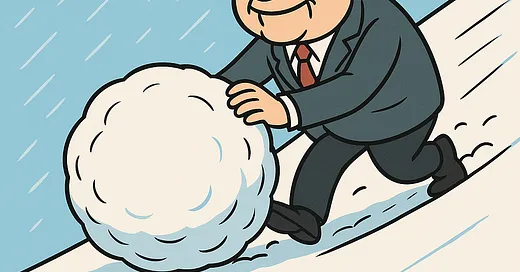People often say, “We can’t invest like Warren Buffett—he’s already rich!”
But let’s hear what Buffett himself says.
Buffett’s Snowball Wisdom: 3 Stories That Changed How I See Compounding
Buffett once summed up his entire philosophy in a single, vivid line:
“Life is like a snowball. The trick is finding wet snow and a really long hill.”
That’s his way of saying: to build great wealth, you don’t need magic. You need time and compounding. Wet snow = high returns. A long hill = a long time to let those returns grow.
Buffett understood this deeply—even in his early 30s. In letters to his partners back in the early 1960s, he shared three eye-opening examples that showed just how powerful compounding can be.
📘 Story #1: $30,000 → $2 Trillion
Buffett once joked that Queen Isabella’s $30,000 investment in Columbus’ journey is often seen as a bold and successful bet.
But what if, instead of chasing the New World, she’d put that money into an investment earning 4% a year?
By 1962, that $30,000 would’ve grown to over $2 trillion.
That’s not government-inflated money—that’s real value. The point? You don’t need to conquer continents. You just need time and steady returns.
🎨 Story #2: The Mona Lisa and $10 Quadrillion
In 1540, King Francis I of France bought Leonardo da Vinci’s Mona Lisa for about 4,000 écus—roughly $20,000 today.
Beautiful painting? No doubt. But what if he’d put that $20,000 into an investment earning 6% annually, after taxes?
By 1963, that would have ballooned into $10 quadrillion—more than 3,000 times France’s national debt at the time.
So, yes, art may be priceless. But compounding? It might just be more powerful.
🏙️ Story #3: Manhattan for $24
You’ve heard this one: Native Americans “sold” Manhattan to the Dutch in 1626 for $24. At today’s real estate prices, that land is worth around $12.5 billion.
Sounds like a massive loss, right?
Well, if that $24 had compounded at 6.5% annually, it would now be worth over $42 billion. At 7%, it jumps to over $205 billion.
So who really got the better deal? Depends how you invested the money.
📊 One Small % Makes a Huge Difference
In his 1963 letter, Buffett included a table showing just how much of a difference a small change in return rate can make over time.
He wrote:
“To achieve such extraordinary results, you need two things: a long lifespan—and a slightly higher return rate. Even small differences in annual performance produce dramatic changes when stretched across decades.”
Here’s proof:
From 1965 to 2010, Buffett’s Berkshire Hathaway returned 20.2% per year, while the S&P 500 returned 9.4%. That’s only a 10.8% annual gap.
But over 46 years, that small difference led to a cumulative gain of over 90,000%—compared to just 6,200% for the index.
🧠 What It All Means
In 1994, Buffett told students at the University of Nebraska:
“Compounding is like rolling a snowball down a hill. Start with a small ball. Roll it long enough. Keep the snow wet enough. In time, you’ll have something massive.”
The big lesson?
You don’t need to be rich to start. You just need time, discipline, and a little bit of that “wet snow.”
So, have you found your long hill?
And are you rolling your own snowball yet?

